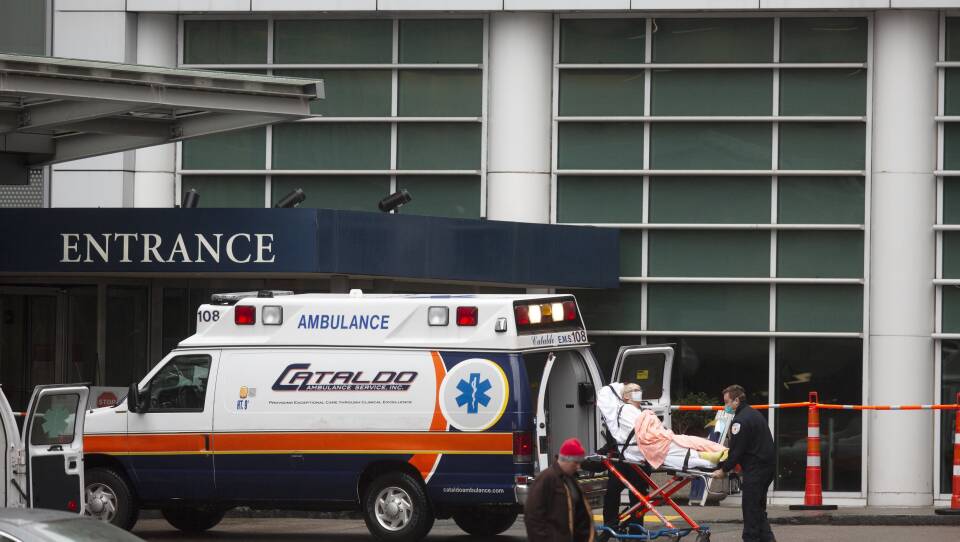On February 1, local media covered the first confirmed case of COVID-19 in Massachusetts, involving a UMass Boston student who’d just returned from Wuhan, China. In a letter to the UMass Boston community, the school's interim chancellor said the risk was low and that it would be "business as usual" on campus.
Over the next two months, though, the idea that the new coronavirus and ordinary life could coexist became untenable. On March 8, Boston announced five presumptive cases, all linked to a Biogen conference in late February. A day later, Mayor Marty Walsh canceled the St. Patrick’s Day Parade. The day after that, Gov. Charlie Baker announced a state of emergency and urged people to start changing the way they work and live.
"Our goal," Baker said, "needs to be to significantly increase efforts to mitigate the spread of this disease now."
But mitigation proved difficult. On March 15, when the governor closed schools and banned gatherings of 25 or more people, Massachusetts had 164 COVID-19 cases. Three weeks later — when Walsh told Bostonians to wear masks in public, and announced a citywide curfew — the state total was 12,500.
Those numbers reflect ramped-up testing, as well as the disease’s spread. But they also point toward the ominous period we’re now entering: the so-called “surge,” when the numbers of coronavirus patients and fatalities will skyrocket. It’s already happened in China, Italy and New York. Now, it’s about to happen here.
"I don’t know how bad it’s going to get, to be honest with you," said Jon Santiago, a state representative and ER doctor at Boston Medical Center. "But I do know that people will be sick, and they’re going to be looking for some help, and I’m going to be there to provide it."

For the past few weeks, Santiago has watched the hospital gear up for what’s coming by ending elective surgeries and turning typical floors into ICUs. For him, Santiago says, the surge will basically be a more intense version of the work he does every day.
"We are upfront and personal with very sad things, whether that’s a young person who’s been shot or people who can’t afford their medications," Santiago said. "So we see death and dying all the time.
"The issue with this — the difference is — just the amount and sheer volume that we’re going to see is going to be challenging."
That may be an understatement. The Institute for Health Metrics and Evaluation currently predicts the surge in Massachusetts will peak on April 20, requiring more than 8000 hospital beds, nearly 1900 ICU beds and nearly 1600 ventilators. If those estimates are right, the state may simply not be able to provide care to everyone who needs it. The institute also projects that single-day coronavirus deaths will crest around this time, forecasting 213 fatalities on April 18 and 212 on April 22.
As Walsh gets ready for what's ahead, he’s grappling with some unprecedented questions.
"If we have to do a more stricter shelter in place," Walsh said, "how are we going to get food to school kids? How do we get food to our elderly, and people who are shut in?
"How do we make sure we continue the messaging every day, so we’re consistent and not sending mixed messages?" he added. "How do we make sure our police are prepared for anything that might be coming, or our fire [department]? How do we make sure our water supply is safe?"
Ordinarily, Walsh says, he leaves his job “on the front porch” when he gets home. Right now, that's impossible. So as he tries to maintain some personal balance as the surge approaches, he's drawing on lessons he’s learned during his recovery from alcoholism.
"You can’t worry about tomorrow, because it’s not here yet," Walsh said. "Yesterday’s gone; I have to live in the present, which is today.
"Thinking about the coronavirus long term — thinking, 'Oh my God, this could go on 4 or 5 months, how am I going to do it,' it becomes overwhelming. But if you deal with it a day at a time, you’ll get through it."
Walsh also cites caring for Boston’s homeless — 200 of whom have already tested positive for COVID 19 — as a constant source of worry. For Lyndia Downie, the president and CEO of the Pine Street Inn, it's the dominant concern as the surge approaches.
"The somewhat good news is, a lot of the people are not in the hospital," Downie said of the homeless who've tested positive. "They’re not, you know, really sick yet."
More good news, according to Downie: She’s been able to place about two hundred other homeless people in alternate housing off site, where they’ll have more privacy, and be less likely to contract the virus or pass it on.
Still, Downie is worried about what the next couple of weeks will bring. She says Pine Street’s staffing is already stretched to the limit, along with its supply of personal protective equipment.
"We got a box of surgical masks yesterday — I jokingly said I’ve never been so excited about a surgical mask in my life," Downie said.
"People are doing their best to get through in the hope that there’s some light at the end of the tunnel. That’s about the only thing keeping people going right now."
First, though, we’ll have to weather a stretch in which things will almost certainly get much worse. Robert Lawler, who runs three funeral homes in greater Boston, says that from his vantage point, it’s already happening.
"We’ve seen probably a half a dozen deaths due to the COVID-19 virus in the past 48 hours," Lawler said. "I think we received four phone calls this morning informing us of people who are infected with the COVID virus, are in a nursing home or in a hospital, and they’re not doing well."
For now, Lawler says, he’s not worried about getting the protective equipment he and his staff need. But he is concerned about what will happen if he or his coworkers get sick, and frustrated by a growing inability to give families in mourning the closure they want.
"I had two calls today, people who passed away in the city of Boston, and they wanted to send their loved ones back to the country where they came from, in this case back to West Africa," Lawler said. "And there’s just no way to do that at this time."
In in the not-too-distant future, however, there may be. If the aforementioned projections are right, daily deaths will start to diminish in late April, and approach zero by late May.
Until then, Santiago, the ER doctor, has two requests. First, keep on social distancing. And second, don’t succumb to despair.
"There is going to be a lot of loss, and a lot of sadness, and a lot of tragedy, but we’re going to get through this," Santiago said. "Just have confidence, and just do the best we can. Ultimately, we’re going to get out of this."





